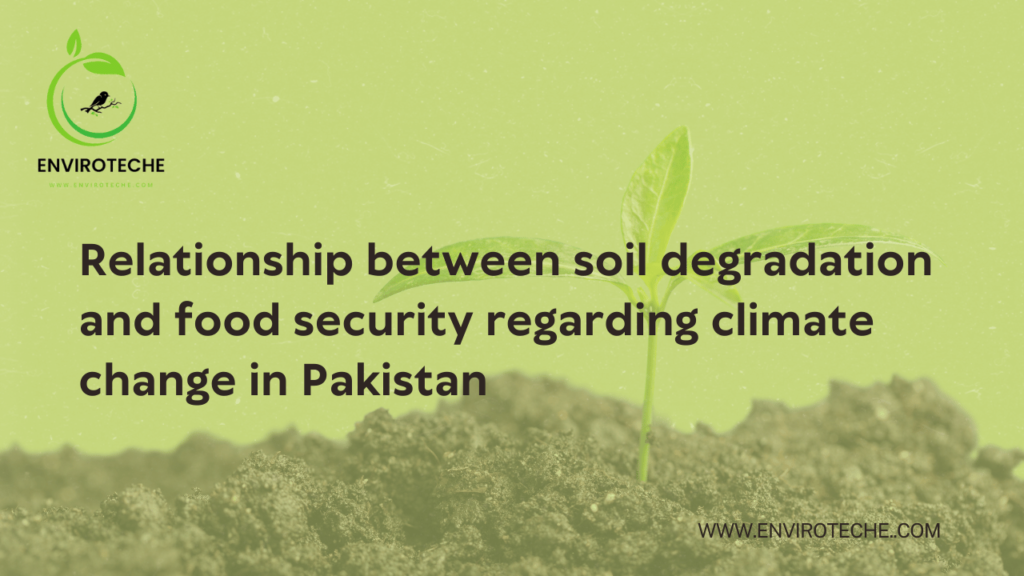
Tayyaba Munir
Department of Environmental Science, International Islamic University Islamabad
Introduction:
When the soil loses its functions and ability to grow crops it becomes considered as soil degraded. Therefore, when the soil reduces its yield its poses a threat to food security, and Pakistan was considered as the 8th largest producer of wheat was always producing enough to meet the local demand because wheat and wheat-based products account for 60-70% of all calorie intake in the country’s population (Niazi, 2023). Globally, Soil erosion, chemical downturn and physical humiliation are the principal factors among different types of soil degradation. Moreover, changing climate is also correlated with soil degradation. Therefore, it is important to fight soil degradation on all levels (Jie et al., 2002).
Food insecurity due to soil degradation
Direct and indirect effects of climate change and resource degradation has badly influenced smallholder farmers and make them stand in a vulnerable position. South Asian countries has been known for its diverse soils, physiography and climates. But, crop yields are at risk to the vagaries of monsoon, in spite of having high rate of irrigation. The main reasons behind soil degradation is excessive use of destructive cultivation, including crop residue removal, the utilization of animal manure as household fuel, and inadequate and imbalanced fertilizer application (Lal, 2010).
Human health and nutrition gets affected by soil degradation because it has adverse impacts on quality and quantity of food production. 70% of Pakistanis live in rural areas and are somehow involved in agriculture. As a result of land degradation Farmers are struggling to make revenues from agricultural activities, and they are also incapable to provide food for their children (Qiu et al., 2017).
Future of soil degradation and threat to developing countries
Because of the world’s ability for replacement and the strength of temperate cultivators, soil degradation is not projected to threaten internationally dealt agricultural commodities. However, it has the potential to have a significant impact on regional agricultural prices and supplies in many countries. Lower farm incomes will have a significant effect on economic expansion, particularly in areas where agriculture is the “engine of growth.”
The most serious threats to the welfare of poor farmers will be found in Sub-Saharan Africa and South Asia’s highly settled marginal areas. The predicted loss of agricultural land does not pose a threat to global wealth in soil resources; however, for regions with a scarce land base, maintaining agricultural land excellence is critical to long-term nutritional stability. Degradation-related challenges will be particularly severe in highly settled marginal areas.
Pakistan-Suffering from Hunger
While the country continues to heal from the catastrophic floods that hit this summer, which authorities predict harm over eighty percent of the country’s agricultural produce, it additionally has to contend with financial turmoil, which has prompted drugs and food to remain in ports. The costs for staple flour, pulses, and non-cereal food items in Pakistan keep on rising, as stated in a late World Food Program report. The price of wheat flour has risen by 74% year on year, according to the report.
According to the WFP report, the cost of grains and their flour has kept on increasing nationwide resulting from a variety of events such as a lack of private wheat supply, stockpiling, and profiteering.” Due to a wheat scarcity in the last few weeks, flour production and distribution have slowed down, resulting in the soaring cost of flour and disorder with Pakistani citizens waiting in line for hours in the hopes of obtaining subsidized bags of flour that are in limited supply, according to the Express Tribune of Pakistan.
Solutions to soil degradation
Soil is an irreplaceable asset, and numerous agricultural cultivation areas are in danger of abandoning it because of negligence caused by an inadequate level of expertise or supervision. Developing understanding and proper care is critical for soil security, however, it cannot be accomplished without first comprehending the fundamental link and relationships that exist between soil and food security.
The government of Pakistan needs to support farmers’ adoption of sustainable supplies, and it should additionally provide agricultural-related institutions to educate farmers in modern farming methods along with offering advanced technology at a subsidy rate.
Farmers who understand how to boost soil fertility using cutting-edge techniques can gain greater yields, which is certainly necessary for living better lives while lowering poverty. There is a desperate requirement for regenerating depleted soils and ecosystems by increasing the organic carbon pool in the soil while establishing beneficial nutrient budgets. To mitigate the negative effects of extreme events on agronomic production, adaptability to changing climates requires advancements in the condition of the soil.
Conclusion:
Security in terms of nutrition and food are intimately connected to land condition. Attempting to cope with increasing food needs by means of inefficient acceleration and governing practices is deteriorating the land and depleting arable land. To prevent additional harm, land should be used in accordance with its capabilities. We must care for the land by taking initiatives to keep it capable and in good condition, or try the initiative has been diminished through regenerative farming.
People’s connections to the land determine management decisions and choices made by customers. Training assists people to connect with and recognize the effects they have on the land, whereas governance and legislation guarantees the land continued security, regrowth, and long-term sustainability. Establishing a Food Security can be challenging if we do not have fertile ground for agricultural cultivation.
References:
Jie, C., Jing-zhang, C., Man-zhi, T., & Zi-tong, G. (2002, April 1). Soil degradation: a global problem endangering sustainable development – Journal of Geographical Sciences. SpringerLink. https://doi.org/10.1007/BF02837480
Lal, R. (2010, January 1). Soil Degradation and Food Security in South Asia. Soil Degradation and Food Security in South Asia | SpringerLink. https://doi.org/10.1007/978-90-481-9516-9_10
Qiu, L. L., Koondhar, M. A., Liu, Y. Y., & Zeng, W. Z. (2017, October 1). Land Degradation is The Instinctive Source of Poverty in Rural Areas of Pakistan – IOPscience. Land Degradation Is the Instinctive Source of Poverty in Rural Areas of Pakistan – IOPscience.
Niazi, A. (2023, April 21). Wheat woes – Our need and inability to grow more. Profit by Pakistan Today. https://profit.pakistantoday.com.pk/2023/04/21/wheat-woes-our-need-and-inability-to-grow-more/
Check Other Schlorships:
